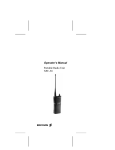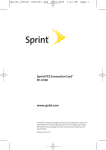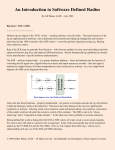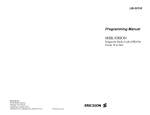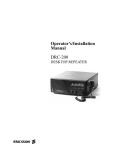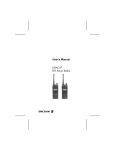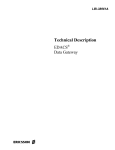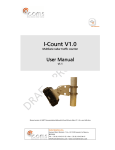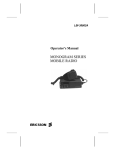Download Ericsson LBI-38505A Specifications
Transcript
LBI-38505A (Supercedes LBI-30025) Maintenance Manual MASTR® II BASE STATION 406-512 MHz RECEIVER TABLE OF CONTENTS RF ASSEMBLY, MIXER AND REFILTER BOARD . . . . . . . . . . . . . LBI-30032 (DF1107) OSCILLATOR/MULTIPLIER BOARD . . . . . . . . . . . . . . . . . . . . LBI-30029 (DF1106) IF AUDIO AND SQUELCH BOARD . . . . . . . . . . . . . . . . . . . . LBI-38507 ericssonz Ericsson Inc. Private Radio Systems Mountain View Road Lynchburg, Virginia 24502 1-800-528-7711 (Outside USA, 804-528-7711) Printed in U.S.A. LBI-38505 LBI-38505 Squelch Sensitivity TABLE OF CONTENTS Page SPECIFICATIONS . . . . . . . . . . . . . . . . . . . . . . . . . . . . . . . . . . . . . . . . 1 DESCRIPTION . . . . . . . . . . . . . . . . . . . . . . . . . . . . . . . . . . . . . . . . . 2 MAINTENANCE . . . . . . . . . . . . . . . . . . . . . . . . . . . . . . . . . . . . . . . . 2 MODIFICATION INSTRUCTIONS (High Side Injection) . . . . . . . . . . . . . . . . . . . . . . . . 3 FRONT END ALIGNMENT . . . . . . . . . . . . . . . . . . . . . . . . . . . . . . . . . . . . 4 ICOM FREQUENCY ADJUSTMENT . . . . . . . . . . . . . . . . . . . . . . . . . . . . . . . . 5 COMPLETE RECEIVER ALIGNMENT . . . . . . . . . . . . . . . . . . . . . . . . . . . . . . . 6 TEST PROCEDURES . . . . . . . . . . . . . . . . . . . . . . . . . . . . . . . . . . . . . . 7 Audio Power Output And Distortion . . . . . . . . . . . . . . . . . . . . . . . . . . . . . . . Usable Sensitivity (12 dB Sinad) . . . . . . . . . . . . . . . . . . . . . . . . . . . . . . . . Modulation Acceptance Bandwidth (IF Bandwidth) . . . . . . . . . . . . . . . . . . . . . . . . . TROUBLESHOOTING PROCEDURES . . . . . . . . . . . . . . . . . . . . . . . . . . . . . . . Frequency Stability ±0.0002% (-40°C to +70°C) 2C-ICOMs ±7 kHz (narrow-band) Modulation Acceptance Maximum Frequency Separation Full Specifications 3 dB Degradation 406-470 MHz 470-494 MHz 494-512 MHz 1.60 MHz 1.50 MHz 1.50 MHz 2.0 MHz 2.0 MHz 2.0 MHz 7 8 8 Frequency Response Within +2 and -8 dB of a standard 6 dB per octave de-emphasis curve from 300 to 3000 Hz (1000 Hz reference) 8 RF Input Impedance 50 ohms *These specifications are intended primarily for the use of the serviceman. Refer to the appropriate Specification Sheet for the complete specifications. ILLUSTRATIONS FIGURE 1 - DISASSEMBLY PROCEDURE (Top View) 0.25 µV 0.1 µV Greater than 12 dB NQ (less than 1.0 µV) Critical Squelch Maximum Squelch . . . . . . . . . . . . . . . . . . . . . . . . 2 FIGURE 2 - RECEIVER BLOCK DIAGRAM . . . . . . . . . . . . . . . . . . . . . . . . . . . . . 2 FIGURE 3 - DISASSEMBLY PROCEDURE (Bottom View) . . . . . . . . . . . . . . . . . . . . . . . 3 FIGURE 4 - RECEIVER MODULE LOCATION DIAGRAM . . . . . . . . . . . . . . . . . . . . . . 3 FIGURE 5 - TEST POINTS AND ALIGNMENT CONTROLS . . . . . . . . . . . . . . . . . . . . . . 4 FIGURE 6 - TEST SETUP FOR 20 Hz DOUBLE-TRACE SWEEP ALIGNMENT . . . . . . . . . . . . . . 4 FIGURE 7 - FREQUENCY CHARACTERISTICS vs. TEMPERATURE . . . . . . . . . . . . . . . . . . 5 WARNING Although the highest DC voltage in MASTR II receiver is +12 Volts DC, high current may be drawn under short circuit conditions. These currents can possibly heat metal objects such as tools, rings, watchbands, etc., enough to cause burns. Be careful when working near energized circuits! High-level RF energy in the transmitter Power Amplifier assembly can cause RF burns upon contact. Keep away from these circuits when the transmitter is energized! SPECIFICATIONS* Audio Output (to 8-ohm Speaker) 1 Watt at less than 3% distortion Sensitivity With Pre-Ampl Without Pre-Ampl 0.20 µV 0.25 µV 0.35 µV 0.50 µV -90 dB -90 dB Spurious Response -90 dB -100 dB Intermodulation (EIA) -75 dB -80 dB 12 dB SINAD (EIA Method) 20 dB Quieting Method SELECTIVITY EIA Two-Signal Method (25 kHz Spacing) Copyright © May 1990, Ericsson GE Mobile Communications Inc. 1 LBI-38505 LBI-38505 Remove the top cover, then loosen the two bottom cover retaining screws and remove the bottom cover (see Figure 1). DESCRIPTION MASTR II Base Station, 406 to 512 megahertz receivers are single conversion, superheterodyne FM receivers designed for one-through eight-frequency operation. The solid state receiver utilizes integrated circuits (ICs), monolithic crystal filters and discrete components with each of the crystal filters located between gain stages to provide 100 dB selectivity and maximum protection from de-sensitization and intermodulation. 3. To gain access to the bottom of the Osc/Mult and IFAS board, remove the six screws (A) holding the receiver bottom cover (see Figure 3). NOTE Refer to Figure 4 for receiver module location. The receiver consists of the following modules: • RF Assembly (Includes Mixer) • IF-Filter • Oscillator/Multiplier (Osc/Mult) • IF/Audio and Squelch (IFAS) • Optional Ultra-High Sensitivity (UHS) Pre-Amplifier Audio, supply voltages and control functions are connected to the system board through P903 on the Osc/Mult board, and P904 on the IFAS board. The regulated +10 Volts is used for all receiver stages except the audio PA stage which operates from the A+ system supply. Centralized metering jack J601 on the IFAS board is provided for use with Test Set 4EX3A11 or Test Kit 4EX8K12. The test set meters the oscillator, multiplier, IF Detector and IF amplifier stages. Speaker high and low are metered on the system board metering jack. A block diagram of the complete receiver is shown in Figure 2. To remove the OSC/Mult board from the radio: 1. Remove the six screws (A) holding the receiver bottom cover. 2. Remove the eight screws (E) holding the IF-Filter bottom cover. 3. Remove the four screws (B) holding the board. 4. Press straight down on the plug-in Osc/Mult board from the top to avoid bending the pins when unplugging the board from the system board jack. To remove the IFAS board from the radio: 1. Remove the six screws (A) holding the bottom cover, and the one screw (C) holding the board. 2. Remove the two screws (D) holding the audio PA heatsink to the right side rail. Refer to the appropriate Maintenance Manual for complete details on each receiver module listed in the Table of Contents. MAINTENANCE DISASSEMBLY To service the Receiver from the top (see Mechanical Parts Breakdown): 1. Pull the locking handle down, then pry up the top cover at the front notch and lift off the cover. To service the Receiver from the bottom: 1. Pull the locking handle down and pull the radio out of the mounting frame. Figure 2 - Receiver Block Diagram 2. 2 Figure 1 - Disassembly Procedure (Top View) LBI-38505 MODIFICATION INSTRUCTIONS To remove the IF Filter board from the radio: 1. MODIFICATION INSTRUCTIONS FOR UHF HIGH SIDE INJECTION APPLYING 19A130045G5 KIT. THIS MODIFICATION IS NOT REQUIRED FOR RECEIVERS OPERATING IN THE FOLLOWING RANGES. Remove the eight screws (E) holding the IF Filter bottom cover. 2. Remove the six screws (F) holding the IF Filter top cover. 3. Remove the three screws (G) and the Connector (H), and carefully push down on the top of the board to avoid damaging the feedthrough capacitors. 450 TO 458.8 MHz 470 TO 482.8 MHz 494 TO 500.8 MHz 1. Remove the eight screws (E) holding the IF Filter bottom cover, and the six screws (F) holding the IF Filter top cover. 2. Disconnect the two connectors and 10 Volt lead (J). 3. Remove the three screws on the bottom side of the board, and lift out the board. FOR RECEIVERS OPERATING BETWEEN 458.8 TO 470 MHz (OSC/MULT BD’S 19D423266G2 & G6): A. IF THE RECEIVER HAS LESS THAN 8 ICOMS, REMOVE C407, C412, C417. REPLACE C407 WITH C2315 (13 pF, -N80). REPLACE C412 WITH C2316 (5pF, NPO). B. IF THE RECEIVER HAS MORE THAN 8 ICOMS, REMOVE C407, C412, C417. REPLACE C407 WITH C2317 (8pF, N80). REPLACE C412 WITH 2316 (5pF, NPO) To remove the optional UHS pre-amplifier board: 1. LBI-38505 2. FOR RECEIVERS OPERATING BETWEEN 482.8 TO 494 MHz (OSC/MULT BD’S 19D423266G3 & G7): A. IF THE RECEIVER HAS LESS THAN 8 ICOMS, REMOVE C407, C412, C417. REPLACE C407 WITH C2318 (10pF, N80). REPLACE C412 WITH C2319 (4pF, NPO). B. IF THE RECEIVER HAS MORE THAN 8 ICOMS, REMOVE C407, C412, C417. REPLACE C407 WITH C2320 (6pF, N80). REPLACE C412 WITH C2319 (4pF, NPO). 3. FOR RECEIVERS OPERATING BETWEEN 500.8 TO 512.0 MHz (OSC/MULT BD’S 19D423266G4 & G8): A. IF THE RECEIVER HAS LESS THAN 8 ICOMS, REMOVE C407, C412, C417. REPLACE C407 WITH C2317 (8pF, N80). REPLACE C412 WITH C2321 (3pF, NPO). B. IF THE RECEIVER HAS MORE THAN 8 ICOMS, REMOVE C407, C412, C417. REPLACE C407 WITH C2316 (5pF, N80). REPLACE C412 WITH C2321 (3pF, NP0). Figure 3 - Disassembly Procedure (Bottom View) 4. SOLDER ALL ELECTRICAL CONNECTIONS. DISCARD CAPACITORS NOT USED. 5. IN APPLICATION OF THIS KIT THE CRYSTAL OSCILLATOR FREQUENCY MUST BE CHANGED PER THE FOLLOWING FORMULA: FX= Fo + 11.2 27 Figure 4 - Receiver Module Location Diagram 6. MARK ALL OSC/MULT BD’S (19D423266) WITH A BLUE COLOR DOT IN THE AREA OF THE PL DRAWING NO. PER 19A115740P1. 7. APPLY LABEL (19A130206P3) TO SIDE OF PLASTIC FRAME. 8. TEST AND ALIGN PER NORMAL PROCEDURE. HIGH SIDE INJECTION 3 LBI-38505 LBI-38505 FRONT END ALIGNMENT EQUIPMENT REQUIRED 1. Test Set Models 4EX3A11, 4EX8K12, or 20,000 ohms-per-Volt multimeter with a 1 Volt scale. 2. A 406-512 MHz signal source. PRELIMINARY CHECKS AND ADJUSTMENTS 1. Connect black plug from Test Set to Receiver Centralized Metering Jack J601, and red plug to system board metering jack J905. Set meter sensitivity switch to the TEST 1 position (or 1-Volt position on 4EX8K12). 2. For multi-frequency receivers with a frequency spacing up to 0.800 MHz for frequency range of 406-470 MHz, 0.900 MHz for frequency range of 470-494 MHz or 0.750 MHz for frequency range of 494-512 MHz, align the receiver on the channel nearest center frequency. For multi-frequency receivers with a frequency spacing exceeding the above but no greater than 1.60 MHz for frequency range of 406-470 MHz, 1.80 MHz for frequency range of 470-494 MHz, or 1.50 MHz for frequency range of 494-512 MHz, align the receiver using a center frequency tune-up ICOM. These limits can be extended to 2.00 MHz, 2.30 MHz and 2.00 MHz respectively, with 3 dB degradation in standard receiver specifications. 3. With Test Set in Position J, check for regulated +10 Volts. If using multimeter, measure between J905-3 (+) and J905-9 (-). 4. If using multimeter, connect the negative lead to J601-9 (A-). 5. Disable Channel Guard. ALIGNMENT PROCEDURE METERING POSITION STEP TEST SET INTERNAL MULTIMETER METERING -AT J601-9 TUNING CONTROL METER READING PROCEDURE C406 Maximum Tune C406 for maximum meter reading. C411, C416, C306, C307 and C308 See Procedure Preset C411 and C416 to a position similar to C406. Next, preset C306, C307 and C308 fully counterclockwise. (Minimum capacity.) Figure 5 - Test Points And Alignment Controls OSCILLATOR/MULTIPLIER 1. C 3 (MULT-1) (MULT-1) Pin 3 2. 3. D 4 (MULT-2) (MULT-2) Pin 4 C411, C416, C406 See Procedure Tune C411 and C416 for maximum meter reading. Next, retune C406, C411 and C416 for maximum meter reading. Then carefully tune C306 for a change in meter reading (peak or dip). 4. F 5 (MULT-3) (MULT-3) Pin 7 C306, C307 & C308 See Procedure Carefully tune C307 and C306 for maximum meter reading. Repeat the procedure. Next, carefully tune C308 for minimum meter reading, and retune C306 for maximum meter reading. Do NOT readjust C307 and C308. RF SELECTIVITY NOTE: IF AMP meter range is 0-700 mVdc with a high impedance DC voltmeter. 5. B 2 (IF AMP) Pin 1 C301 thru C305, A303-C2, (and L2301 if present) Maximum Apply an on-frequency signal to antenna jack, keeping the signal below saturation. Then tune C301 through C305 and A303-C2 for maximum meter reading. In receivers with the UHS preamplifier, also tune L2301 for maximum meter reading. 6. B 2 (IF AMP) Pin 1 C301 thru C305, A303-C2, C306, C307 and C308 (L2301 if present) Maximum Apply an on-frequency signal to the antenna jack and slightly tune C301 through C305, A303-C2, (L2301 if present) for best quieting sensitivity. C306, C307 and C308 also may be tuned slightly (not to exceed 1/4 turn). Figure 6 - Test Setup For 20 Hz Double-Trace Sweep Alignment 406-512 MHz MASTR II RECEIVER 4 LBI-38505 LBI-38505 ICOM FREQUENCY ADJUSTMENT The frequency of the "beat" is the frequency error, related to the IF frequency. This deviation, in Hz, is compared to the receiver operating frequency, also in Hz, to calculate the error in PPM. NOTE The FM Detector output (meter position A of the test set) has a DC voltage of +0.35 to 0.5-Volts with an ON-FREQUENCY signal or under NO-SIGNAL conditions and is provided for routine test and measurement only. The resolution of this reading (approximately .025 V per kHz as read on a Test Set in meter position A, or 0.1 V per kHz as measured with a VTVM at P904-3 or J601-2 on the IFAS board) is inadequate for oscillator frequency setting. First, check the frequency to determine if any adjustment is required. The frequency measurement requires equipment with an absolute accuracy which is 5 to 10 times better than the tolerance to be maintained. When performing frequency measurement, the entire radio should be as near as possible to an ambient temperature of 26.5°C (79.8°F). MASTR II ICOMs should be reset only when the measured frequency error exceeds the following limits. A. ±0.5 PPM, when the radio is at 26.5°C (79.8°F). B. ±2 PPM at any other temperature within the range -5°C to +55°C (+131°F). C. The specification limit (±2 PPM or ±5 PPM) at any temperature within the ranges -40°C to -5°C (-40°F to +23°F) or +55° to +70°C (+131°F to +158°F). If the radio is at an ambient temperature of 26.5°C (79.8°F), set the oscillator for the correct mixer frequency (ICOM FREQ. X 9). If the radio is not an ambient temperature of 26.5°C, setting errors can be minimized as follows: A. If frequency adjustment is required, lift up the cover on the top of the ICOM (where present) to expose the adjustment trimmer. Depending upon the type of frequency measuring equipment that is available, any of the following procedures may be used: A. 2. WITH A COMMUNICATION MONITOR (for example: Cushman Model CE-3). "Monitor" frequency at the junction of C416 and L403 on the Oscillator/Multiplier Board. The frequency monitored at this point is 9 times the ICOM frequency. NOTE: This frequency will not always fall within an available measuring range of all monitors at all receiver operating frequencies. B. 1. Maintain the radio at 26.5°C (±5°C) and set the oscillator to require mixer injection frequency, or DIRECT MEASUREMENT IN THE INJECTION CHAIN 1. WITH A FREQUENCY COUNTER. "Count" the frequency at the junction of C416 and L403 on the Oscillator/Multiplier Board. The frequency measured at this point is 9 times the ICOM frequency. NOTE: The output from the ICOM itself is not sufficiently sinusoidal for reliable operation with most frequency counters. STANDARD "ON FREQUENCY" SIGNAL AT THE RECEIVER INPUT (Generated from a COMMUNICATION MONITOR, for example: Cushman Model CE-3). To hold setting error to ±0.6 PPM (which is considered reasonable for 5 PPM ICOMS): 2. Maintain the radio at 26.5°C (±10°C) and offset the oscillator, as a function of actual temperature, by the frequency error factor shown in Figure 7. B. To hold setting error to ±0.35 PPM (which is considered reasonable for 2 PPM ICOMS): Maintain the unit at 26.5°C (±5°C) and offset the oscillator, as a function of actual temperature, by the frequency error factor shown in Figure 7. For example: Assume the ambient temperature of the radio is 18.5°C (65.4°F). At that temperature, the curve shows a correction factor of 0.3 PPM. (At 138 MHz, 1 PPM is 138 Hz. At 174 MHz, 1 PPM is 174 Hz). With a mixer injection of 150 MHz, adjust the oscillator for a corrected mixer injection frequency 45 Hz (0.3 X 150 Hz) higher. If a negative correction factor is obtained (at temperatures above 26.5°C), set the oscillator for the indicated PPM lower than the calculated mixer injection frequency. 1. WITH A FREQUENCY COUNTER. "Count" the developed IF frequency at the top of Z602-R2 on the IFAS board. The deviation from the nominal IF frequency (11.2 MHz) in Hz is compared to the receiver operating frequency (also in Hz) to calculate error in PPM. 2. WITH AN 11.2 MHz IF FREQUENCY STANDARD (for example: Model 4EX9A10). Loosely couple the IF frequency standard to the IF signal path to create a heterodyne with the developed IF frequency. The resultant "beat frequency" can be monitored by either of the following methods: a. Audible "beat frequency" from the receiver speaker (this requires careful frequency adjustment of the frequency standard). NOTE To SET ICOM frequency using "beat frequency" method, the temperature should be at 26.5°C (79.8°F). If the temperature is not 26.5°C, then offset the "on frequency" signal (at the receivers input), as a function of actual temperature, by the frequency error factor (in PPM) shown in Figure 7. b. Observe "beat frequency" at P904-4 with an Oscilloscope. c. With TEST SET (Meter Position B) connected to J601 on the IFAS Board, visually observe the "beat frequency" indicated by meter movement. Figure 7 - Frequency Characteristics Vs. Temperature 406-512 MHz MASTR II RECEIVER 5 ALIGNMENT PROCEDURES LBI-38505 COMPLETE RECEIVER ALIGNMENT LBI-38505 METERING POSITION EQUIPMENT REQUIRED STEP TEST SET INTERNAL METERING MULTIMETER -AT J601-9 TUNING CONTROL METER READING PROCEDURE 1. Test Set Models 4EX3A11, 4EX8K12, or 20,000 ohms-per Volt multimeter with a 1- Volt scale. 2. An 11.2 MHz signal source (Test Set Model 4EX9A10). Also a 406-512 MHz signal source with a one-inch piece of insulated wire no larger than .065 inch diameter connected to generator probe. NOTE: IF AMP meter range is 0-700 mVDC with a high impedance DC voltmeter. 3. DVM. 6. B (IF AMP) 2 (IF AMP) Pin 1 C305, C304 and A303-C2 Maximum 4. Distortion Analyzer. Preset A303-C2 to mid position. Apply an on-frequency signal in the hole adjacent to C304, keeping the signal below saturation. Then tune C305, C304 and then A303-C2 for maximum meter reading. 7. B (IF AMP) 2 (IF AMP) Pin 1 C304 and C303 Maximum Apply an on-frequency signal in the hole adjacent to C303, keeping the signal below saturation. Then tune C304 and C303 for maximum meter reading. For multi-frequency receivers with a frequency spacing up to 0.800 MHz for frequency range of 406-470 MHz, 0.900 MHz for frequency range of 470-494 MHz, or 0.750 MHz for frequency range of 494-512 MHz, align the receiver on the channel nearest center frequency. 8. B (IF AMP) 2 (IF AMP) Pin 1 C303 and C302 Maximum For multi-frequency receivers with a frequency spacing exceeding the above but no greater than 1.60 MHz for frequency range of 406-470 MHz, 1.80 MHz for frequency range of 470-494 MHz, or 1.50 MHz for frequency range of 494-512 MHz, align the receiver using a center frequency tune-up ICOM. These limits can be extended to 2.00 MHz, 2.30 MHz and 2.00 MHz respectively, with 3 dB degradation in standard receiver specifications. Apply an on-frequency signal in the hole adjacent to C302, keeping the signal below saturation. Then tune C303 and then C302 for maximum meter reading. 9. B (IF AMP) 2 (IF AMP) Pin 1 C301 thru C305, A303-C2 (and L2301 if present) Maximum Apply an on-frequency signal to the antenna jack, keeping the signal below saturation. Then tune C301 through C305 and A303C2 for maximum meter reading. In receivers with the UHS preamplifier, also tune L2301 for maximum meter reading. 10. B (IF AMP) 2 (IF AMP) Pin 1 C301 thru C305, A302-C2, C306, C307 & C308 (L2301 if present) Maximum Apply an on-frequency signal to the antenna jack and slightly tune C301 through C305, A303-C2 (and L2301 if present) for best quieting sensitivity. C306, C307 & C308 also may be tuned slightly not to exceed 1/4 turn). L603, R609 See Procedure Remove the Test set metering plug from J601. Apply a 1000 microvolt signal with 1 kHz modulation and 3 kHz deviation to the antenna jack. Tune L603 for maximum voltage at 1.0 kHz and adjust R609 for 1 Volt RMS measured with a DVM at P904-11 (VOL/SQ HI) and P904-17 (A-). RF AMP & SELECTIVITY PRELIMINARY CHECKS AND ADJUSTMENTS 1. Connect the black plug from the Test Set to receiver metering jack J601, and the red plug to system board metering jack J905. Set the meter sensitivity switch to the Test 1 (or 1- Volt position on the 4EX8K12). 3. With the Test Set in Position J, check for regulated +10 Volts. With multimeter, measure from J905-3 to J905-9. 4. If using multimeter, connect the negative lead to J601-9 (A-) 5. Disable the Channel Guard. ALIGNMENT PROCEDURE 11. METERING POSITION STEP TEST SET INTERNAL METERING MULTIMETER -TO J601-9 TUNING CONTROL METER READING PROCEDURE FM DETECTOR 1. A (FM DET) 1 (FM DET) Pin 2 L603 0.38 Volt With no signal applied, adjust L603 for a meter reading of approximately 0.38 Volt. OSCILLATOR/MULTIPLIER 2. C (MULT-1) 3 (MULT-1) Pin 3 3. MIXER & IF The mixer and IF circuits have been aligned at the factory and will normally require no further adjustment. If adjustment is necessary, use the procedure outlined in STEP 13. NOTE Refer to DATAFILE BULLETIN 1000-6 (IF Alignment of Two-Way Radio FM Receivers) for helpful suggestions on how to determine when IF Alignment is required. C406 Maximum Tune C406 for maximum meter reading. C411, C416, C306, C307 and C308 See Procedure Preset C411 and C416 to a position similar to C406. Next, preset C306, C307 and C308 fully counterclockwise (minimum capacity). 4. D (MULT-2) 4 (MULT-2) Pin 4 C411, C416, C406 See Procedure Tune C411 and C416 for maximum meter reading. Next, retune C406, C411 and C416 for maximum reading. Then carefully tune C306 for a change in meter reading (peak or dip). 5. F (MULT-3) 5 (MULT-3) Pin 7 C306, C307 and C308 See Procedure Carefully tune C307 and C306 for maximum meter reading. Repeat the procedure. Next carefully tune C308 for minimum meter reading. Do NOT readjust C307 and C308. 12. L507, L503, L504 and C504, T601, T602, and T603 Connect scope, signal generator, and probe as shown in Figure 6. Set signal generator level for 3 to 5 µV and modulate with 20 Hz at 12 kHz deviation. With probe between P904-4 (or J601-1) and A-, tune L507, L503, L504, C504, T601, T602, and T603 for double trace as shown on scope pattern. Preset T601-T603 to top of coil form before tuning. Cont’d. 13. See Procedure Check to see that modulation acceptance bandswidth is greater than ±7 kHz. 406-512 MHz MASTR II RECEIVER 6 TEST PROCEDURES LBI-38505 TEST PROCEDURES These Test Procedures are designed to help you to service a receiver that is operating---but not properly. The problems encountered could be low power, poor sensitivity, distortion, limiter not operating properly, and low gain. By following the sequence of test steps starting with Step 1, the defect can be quickly localized. Once the defective stage is pin-pointed, refer to the "Service Check" listed to correct the problem. Additional corrective measures are included in the Troubleshooting Procedure. Before starting with the Receiver Test Procedures, be sure the receiver is tuned and aligned to the proper operating frequency. PRELIMINARY ADJUSTMENTS 1. Connect the test equipment to the receiver as shown for all steps of the receiver Test Procedure. 2. Turn the SQUELCH control fully clockwise for all steps of the Test Procedure. TEST EQUIPMENT REQUIRED • Distortion Analyzer similar to: HP331A, or an equivalent average response meter • Signal Generator similar to: HP8640B • 6-dB attenuation pad, and 8.0 ohm, 2-Watt resistor 3. Turn on all of the equipment and let it warm up for 20 minutes. LBI-38505 STEP 1 AUDIO POWER OUTPUT AND DISTORTION TEST PROCEDURE Measure Audio Power Output as follows: A. Apply a 1,000 microvolt, on frequency test signal modulated by 1,000 Hertz with 3.0 kHz deviation to antenna jack A301-J1. B. Disconnect speaker lead pin from System Plug P701-11 (on rear of Control Unit). Connect an 8.0-ohm, 2-Watt load resistor from P904-19 (SPKR H1) to P904-18 (SPKR LO) or from P701-4 to P701-17 (SPKR HI) on the System Plug. Connect the Distortion Analyzer input across the resistor as shown. OR WITH HANDSET: Lift the handset off of the hookswitch. Connect the Distortion Analyzer input from P904-19 to P904-18. C. Adjust the VOLUME control for one Watt output using the Distortion Analyzer as a Voltmeter. D. Make distortion measurements according to manufacturer’s instructions. Reading should be less than 3%. If the receiver sensitivity is to be measured, leave all controls and equipment as they are. SERVICE CHECK If the distortion is more than 3%, or maximum audio output is less than 1 Watt, make the following checks: E. Power Supply and regulator voltage---low voltage will cause distortion. (Refer to Receiver Schematic Diagram for voltages.) F. Audio Gain (Refer to Receiver Troubleshooting Procedure.) G. FM Detector Alignment (Refer to Receiver Alignment.) 7 LBI-38505 TEST PROCEDURES TROUBLESHOOTING PROCEDURES STEP 2 USABLE SENSITIVITY (12 dB SINAD) STEP 1 - QUICK CHECKS If STEP 1 checks out properly, measure the receiver sensitivity as follows: A. Apply a 1000 microvolt, on frequency signal modulated by 1000 Hz with 3.0 kHz deviation to A301-J1. B. With Function Switch on Distortion Analyzer set to VOLTMETER position, adjust volume control for 1.0 Watt (2.83 VRMS across 8 ohm load). Again, verify that audio output is nulled when Function Switch is set to DISTORTION position. C. D. TEST SET CHECKS These checks are typical readings measured with Test Set Model 4EX3A11 in the Test 1 position, or Model 4EX8K12 in the 1-Volt position. Place the RANGE switch to the SET LEVEL position (filter out of the circuit) and adjust the input LEVEL control for a +2 dB reading on a 30% range. While reducing the signal generator output, switch the FUNCTION control from SET LEVEL to the DISTORTION until a 12 dB difference (+2 dB to -10 dB) is obtained between the SET LEVEL and DISTORTION positions (filter out and filter in). E. The 12 dB difference (Signal plus Noise and Distortion to noise plus distortion ratio) is the "usable" sensitivity level. The sensitivity should be less than rated 12 dB SINAD specifications with an audio output of watt across the 8.0 ohm load. F. Leave all controls as they are and all equipment connected if the Modulation Acceptance Bandwidth test is to be performed. SERVICE CHECK If the sensitivity level is more than the rated 12 dB SINAD specification, check the alignment of the RF stages as directed in the Alignment Procedure, and make the gain measurements as shown on the Troubleshooting Procedure. STEP 3 MODULATION ACCEPTANCE METERING READING READING WITH- TEST POSITION WITH NO 10 MICROVOLTS POSITION SIGNAL IN (UNMODULATED) A (FM DET) Approximately 0.38 VDC B (IF Amp) C (Mult-1) 0.4 VDC D (Mult-2) 0.4 VDC F (Mult-3) 0.1 VDC J (Reg. +10 Volt at System Metering +10 VDC SYMPTOM CHECKS SYMPTOM PROCEDURE NO SUPPLY VOLTAGE • Check power connections, continuity of supply leads. Check fuse and replace if blown. Check receiver for short circuits. NO REGULATED 10-VOLTS • Check the 12 Volt supply. Then check 10 Volt regulator circuit. (See Troubleshooting Procedure for 10 Volt Regulator). LOW IF READING • Check supply voltages and then check oscillator readings at P904-1 & -2 as shown in STEP 2. • Make SIMPLIFIED GAIN CHECKS from Mixer through Limiter Detector stages as shown in STEP 2. • Check alignment of Oscillator/Multiplier chain. (Refer to Front End Alignment Procedure). • Check voltage readings of Oscillator/Multiplier chain (Q401, Q402, Q403). • Check Front End Alignment. (Refer to Receiver Alignment Procedure). • Check antenna connections, cable and antenna switch. • Check Oscillator injection voltage. • Check voltage readings of IF Amplifiers. • Make SIMPLIFIED GAIN CHECKS (STEP 2). If STEPS 1 and 2 check out properly, measure the bandwidth as follows: Set the Signal Generator output for twice the microvolt reading obtained in the 12- dB SINAD measurement. B. Set the RANGE control on the Distortion Analyzer in the SET LEVEL position (1000-Hz filter out of the circuit), and adjust the input LEVEL control for a +2 dB reading on the 30% range. C. While increasing the deviation of the Signal Generator, switch the RANGE control from SET LEVEL to distortion range until a 12- dB difference is obtained between the SET LEVEL and distortion range readings (from +2 dB to -10 dB). D. The deviation control reading for the 12- dB difference is the Modulation Acceptance Bandwidth of the receiver. It should be more than ±7 kHz. LOW OSCILLATOR/MULTIPLIER READINGS LOW RECEIVER SENSITIVITY SERVICE CHECK Con’t. If the Modulation Acceptance Bandwidth test does not indicate the proper width, make gain measurements as shown on the Receiver Troubleshooting Procedure. 406-512 MHz MSTR II RECEIVER 8 Test 1 (or 1 Volt) 0.1 VDC BANDWIDTH (IF BANDWIDTH) A. LBI-38505 TROUBLESHOOTING PROCEDURES LBI-38505 LBI-38505 SYMPTOM CHECKS Con’t. SYMPTOM PROCEDURE IMPROPER SQUELCH OPERATION LOW OR DISTORTED AUDIO • Check voltages on Schematic Diagram. • Make gain and waveform checks with noise. • Make gain and waveform checks with 6 kHz signal. • Check discrete components in the squelch circuit. • Replace IC circuit U603. • Check voltages on Schematic Diagram. • Make gain and waveform checks. • Check receiver alignment and FM -DET output. • Check Q601, Q602, Q605 and other discrete components. SQUELCH CHECKS SQUELCHED UNSQUELCHED NOISE SQ OUTPUT U605-2 0.2 VDC 9.9V CAS U605-1 0.1 VDC 9.9V RX MUTE U605-14 0.2 VDC 9.9V RUS U605-13 0.2 VDC 4.9V SQ DISABLE SW. INPUT U606-1 0.2 VDC 9.9V AUDIO GATE SW. CONTROL U606-11 0.2 VDC 9.9V If External Decoder is used (CG, DCG, Type 99, etc.), RX Mute will remain low (regardless of noise squelch output), until proper response is decoded. RX Mute = Noise Sq Output• Decoder Output. In above cases, Sq Disable is assumed high (9.9V). If Sq Disable is grounded, U606-10 = 0.2 Vdc, U606-11 = 9.9 Vdc and Unit is unsquelched for all conditions. 9 LBI-38505 406-512 MHz MASTR II RECEIVER 10 TROUBLESHOOTING PROCEDURES LBI-38505 LBI-38505 TROUBLESHOOTING PROCEDURES LBI-38505 406-512 MHz MASTR II RECEIVER 11













